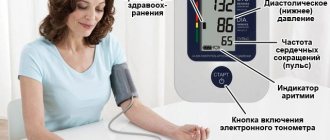Category: Symptoms and conditions
There are many myths associated with intracranial pressure, supported by doctors. Not every headache in an adult or hysterical behavior and trembling in a baby indicates increased intracranial pressure.
The diagnosis of ICP is quite serious and, in most cases, especially when visiting domestic clinics, turns out to be incorrect. Treatment of intracranial pressure is based not only on painful symptoms, but also on instrumental confirmation of the pathology.
What pressure is called intracranial pressure?
Intracranial pressure (ICP) is a variable indicator of the force of pressure on the cranium of brain tissue, blood and cerebrospinal fluid. The normal ICP is 100-151 mm water. Art. or 10-15 mm Hg. Art.
Within these limits, intracranial pressure can change during the day even in a healthy person. However, prolonged excess of the norm provokes the occurrence of serious symptoms requiring medical attention.
ICP 25-35 mm Hg. Art. is critical: the lack of timely medical care is fraught with loss of consciousness and gradual death of the brain.
Increased intracranial pressure occurs with the following disorders:
- Increased brain volume - neuroinfections (meningitis, encephalitis), brain tumors and abscesses, parasitic cysts and atherosclerosis, accompanied by cerebral edema;
- Increased blood volume in the skull - hematomas in traumatic brain injuries and hemorrhagic strokes, abnormal structure of the skull in the area of the connection with the spine and compression of large vessels;
- Delayed outflow of cerebrospinal fluid through the venous sinuses - birth injuries and congenital hydrocephalus.
Metabolic disorders that prevent the absorption of fluid into the blood lead to a gradual increase in ICP
- Severe intoxication, including alcohol;
- Endocrine disorders - obesity, menstrual irregularities, diabetes mellitus in the stage of decompensation, use of oral contraceptives and corticosteroids, pathology of the thyroid gland, pathological pregnancy;
- Blood diseases - leukemia, anemia, hemophilia;
- Other diseases - lupus erythematosus, syphilis, scurvy, thrombocytopenic purpura;
- Taking antibiotics and psychotropic drugs;
- Overdose of drugs containing vit. A.
What kind of disease is this?
With intracranial pressure, cerebrospinal fluid accumulates in a certain part of the skull. Or this liquid may not be enough. The accumulation causes poor circulation. Liquid - liquor
- circulates in the ventricles of the brain, in the spinal cavity, the space between the bones of the skull, bone marrow and brain. The function of cerebrospinal fluid is to protect the “gray matter” from severe overloads and injuries.
Liquor is always under pressure. It is regularly updated and circulates from one area to another. The process should take about a week. But sometimes it is broken, and the liquid begins to accumulate in one place. ICP increases. As fluid decreases, ICP decreases.
Determination methods
Intracranial pressure is checked in the following ways:
- a catheter is inserted into the lumen of the spinal canal or ventricles of the brain, and a pressure gauge is attached, which works like a mercury thermometer;
- perform an examination of the fundus and determine the presence of symptoms: papilledema, blurred contours, pallor;
- patients who have suffered severe cerebrovascular accident undergo a tomographic examination and assessment of the condition of the fundus.
How to measure intracranial pressure in a baby? Using neurosonography and echoencephaloscopy. Neurosonography
— Ultrasound of the brain through the fontanel.
Conducted per month, 3 months, six months. Echoencephaloscopy
is a method for determining intracranial pathology, which is based on echolocation of sagittal brain structures.
Signs of ICP
| Signs of intracranial pressure in adults | Signs of intracranial pressure in infants |
|
|
In most cases, signs of increased intracranial pressure in an infant are due to birth trauma.
Increased ICP in a child, which manifests itself in the first few hours of life, often leads to the development of severe complications. Options for the development of the clinical picture of hypertension:
- the disease manifests itself suddenly, consciousness is impaired to a deep coma;
- probability of death - 92%;
- signs appear gradually.
Causes of the disease
Main causes of the disease:
- the metabolic process is disrupted, the level of fluid absorption into the blood decreases;
- cerebrospinal fluid is unable to circulate through spasmodic vessels;
- excess fluid in the body, which leads to an increase in cerebrospinal fluid;
- the brain increases in volume due to swelling and inflammation;
- the presence of a large neoplasm (tumor, foreign body) in the skull;
- severe poisoning, as a result of which the blood content in the dilated vessels of the brain increases;
- oxygen starvation of the brain;
- hydrocephalus;
- meningitis;
- stroke;
- migraine;
- encephalitis;
- excess weight;
- excess vitamin A;
- traumatic brain injury;
- The child’s cranial bones did not fuse in a timely manner.
In an infant, the disease can develop due to a difficult birth, a complicated pregnancy of the mother, entanglement in the umbilical cord, due to which the child suffers from hypoxia (oxygen starvation). When compensating for the lack of oxygen, fluid production increases, fills the skull, and puts pressure on the brain.
In adults and children, a sudden increase in ICP can lead to death if the condition is not treated.
How to measure ICP?
Many people ask the question: “How to measure intracranial pressure?” It is possible to accurately determine the level of ICP only with the help of brain catheterization. The traumatic nature of this method limits its use, so doctors often resort to other instrumental studies that provide indirect signs of high intracranial pressure:
- Ultrasound of the brain (neurosonography, echoencephaloscopy) - most often performed in newborns up to 1 year, until the large fontanel has closed;
- X-ray of the head - depressions in the temporal bones;
- Hardware examination of the fundus - characteristic swelling of the exit of the optic nerve to the retina;
- CT, MRI - detection of vascular pathology (stenosis and expansion of the subarachnoid space, enlargement of the sinuses and ventricles of the brain, hematomas and areas of ischemia).
You can check intracranial pressure using a spinal puncture: an increase in cerebrospinal fluid pressure most likely confirms a change in intracranial pressure.
What are the signs of increased ICP?
There are certain manifestations that suggest increased intracranial pressure and prompt medical attention. How to determine that ICP has increased on your own?
First of all, these are intense headaches that do not go away after taking painkillers. The pain radiates to the eyeballs, there is a feeling of heaviness and pressure in the eyes, flashing spots, light spots and stripes appear.
In addition, with increased ICP, the patient is bothered by tinnitus, hearing loss, and nausea, which periodically turns into vomiting.
With prolonged elevated ICP, intellectual abilities suffer, character changes, and vision gradually deteriorates.
Children may also experience increased intracranial pressure, which is usually a congenital condition. In this case, hydrocephalus or dropsy of the brain is formed. The head of such children looks disproportionately large in relation to the body. The child is restless, cries often, and has a poor appetite. The fontanelles close much later than in a healthy child.
Absent or untimely treatment can lead to the formation of a brain aneurysm and the development of a stroke.
CSF pressure may increase due to various diseases:
- brain tumors, benign and malignant;
- congenital vascular pathologies;
- infectious meningitis and encephalitis;
- closed craniocerebral injuries.
Treatment of such pathologies is possible only in a neurological or infectious diseases hospital. If a patient with high ICP is identified, urgent hospitalization is necessary. Treatment can be carried out conservatively or surgically.
For conservative treatment, medications are used: diuretics, colloidal solutions for intravenous administration, glucocorticoids. If such therapy is ineffective, surgery is prescribed. In children, the most common procedure is to place a shunt from the ventricles of the brain into the abdominal cavity. In adults, craniotomy is performed to relieve pressure on the brain.
How to determine intracranial pressure when it increases is a natural question that arises among people suffering from symptoms of pathology, the main one of which is a painful headache.
Increased intracranial pressure (ICP), also called intracranial hypertension, is a dangerous condition because prolonged compression of the brain causes deterioration of its functions, structural damage, and in the most severe cases can cause death.
If you suspect intracranial hypertension, you should consult a doctor and undergo an examination, since it is not possible to check intracranial pressure at home. What symptoms may indicate this pathology?
Ophthalmoscopy is a simple, cheap and highly informative method, which is sufficient to diagnose increased ICP.
Signs and symptoms of intracranial pressure in an adult
Symptoms of intracranial pressure in adults usually develop gradually. The patient may attribute the slowly but persistently deteriorating condition to other illnesses.
Symptoms characteristic of ICP:
- Cephalgia
The headache is of a dull, bursting nature, often radiating to the eyeballs (a feeling of “pressure on the eyes”). A characteristic symptom is increased pain in the morning. Moreover, after waking up, the patient feels exhausted, sleep does not bring restoration of strength.
Painful sensations intensify, accompanied by dizziness and fainting conditions with physical overexertion, excessive extension of the head (look at the sky), sneezing and coughing, strong straining during bowel movements, in a horizontal position (daytime sleep).
- Visual and hearing impairment
Temporary darkening or double vision, tinnitus - all this occurs periodically and often accompanies increased pain in the head. Symptoms can be unilateral or bilateral depending on the damage to the corresponding nerves.
In this case, the patient initially cannot look outward, and subsequently develops convergent strabismus. Peripheral visual acuity is noticeably reduced.
With prolonged significant compression of the optic or auditory nerve, for example, by edematous tissue or hematoma, their irreversible atrophy and loss of function occurs (blindness, deafness).
- Brain symptoms
The following symptoms indicate damage to brain structures: nausea and vomiting (sometimes uncontrollable), problems with memory and concentration.
As the pathology develops, motor disturbances (paresis, local paralysis), changes in sensitivity, difficulties with speech occur, and olfactory hallucinations are possible. The patient’s mental state also suffers: from irritability and hysteria to drowsiness and complete apathy.
- Vegetative-vascular disorders
Disturbances in the autonomic system occur even with a slight increase in ICP. High intracranial pressure in adults is accompanied by sweating of the palms and feet, surges in blood pressure (often a sharp decrease) and a decrease in heart rate (bradycardia), fatigue and decreased productivity of activity/work.
The patient has constant “bruises” under the eyes, the face (especially in the eye area) is swollen.
Rapidly increasing intracranial pressure gives rapid development to the following symptoms:
- severe headache, tearing the brain;
- uncontrollable vomiting;
- dilated pupils and poor reaction to light;
- convulsions;
- a sharp increase in a/d, then an equally sharp decrease and bradycardia below 60 beats/min;
- breathing problems;
- loss of consciousness, coma.
The appearance of at least one of these signs requires calling an ambulance and emergency resuscitation measures.
Where can I measure intracranial pressure?
Almost every person is familiar with headaches. But sometimes the pain takes on certain characteristics, and attacks are repeated frequently and regularly. In such cases, it is best for a person to consult a doctor. Already at the appointment, the therapist may suspect increased intracranial pressure. Symptoms of this pathology will include the following:
- Regular headache, which is most pronounced during the first time after waking up. The pain will be bursting in nature and can be localized in any part of the head.
- Unreasonable attacks of nausea or even vomiting.
- Constant feeling of fatigue and apathy.
- Memory and attention are significantly reduced.
- Attacks of dizziness and sometimes loss of consciousness.
- Peripheral vision deteriorates, and over time normal vision begins to decline.
- Sudden pressure surges.
- Very rare pulse.
In cases where the therapist suspects the development of ICP, the patient is sent for further consultations.
Features of symptoms of intracranial pressure in children
Almost every third newborn is diagnosed by domestic specialists with intracranial hypertension. For complaints of chin tremor, hysterical crying and poor sleep, pediatric neurologists like to prescribe entire lists of medications.
Typically, the following symptoms lead doctors to an incorrect conclusion:
- delayed fusion of the fontanel;
- shuddering and tremors;
- disturbed sleep;
- regurgitation during feeding;
- baby walking on tiptoes (most often this is due to hypertonicity of the leg muscles);
- hyperactivity syndrome;
- delayed psychomotor development - does not sit down on time, does not walk, does not speak.
It should be taken into account that intracranial pressure in babies may increase with prolonged screaming. Even cold or hunger often provokes hysterics in a newborn, trembling of arms, legs, and lips.
However, this condition does not require drug intervention. Gradually, the indicators return to normal after the child calms down.
To reliably diagnose high intracranial pressure in a child, the following principles must be observed:
- Intracranial hypertension in children is always accompanied by serious brain damage - hydrocephalus, traumatic brain injury, tumor, etc.
- With ICP, the growth of the baby's head circumference exceeds the normative values.
- The bulging of the fontanelle, and often the divergence of the skull bones, is necessarily recorded.
- Intracranial hypertension gives quite serious symptoms - epileptiform seizures, strabismus, fountain vomiting, impaired consciousness.
The danger of high blood pressure
It is necessary to understand what happens inside the skull when pressure increases. The brain is surrounded by vasculature and cerebrospinal fluid (CSF). Pressure increases when the normal outflow of this substance is disrupted.
The process of increasing pressure can be gradual or sudden. With a gradual increase, adaptation has time to occur within the brain. It is extremely important to solve the problem as soon as possible, since the disease can become chronic, and the consequences will be dire due to the risk of developing a stroke.
Increased intracranial pressure leads to deterioration of cerebral circulation and normal brain activity.
A person notices how sharply memory and reaction deteriorate. Constant headaches can be unbearable. If nothing is done, a mental disorder may even develop.
Increased blood pressure in newborns
Increased intracranial pressure levels are often found in newborns. Although this is a serious symptom, it does not necessarily pose a significant threat. If the deviation from the norm is insignificant, it is possible that the indicators will soon return to normal.
Parents can provide invaluable assistance with this. If you create suitable conditions for the child’s body, in the absence of serious pathologies, his blood pressure will quickly normalize. It is important to spend time with him in the fresh air every day, monitor his diet and carry out a special massage.
If simple measures do not have an effect, and intracranial pressure remains above normal for a long period, measures must be taken. The specialist will prescribe a set of diagnostic measures that will help to accurately determine the cause of the deviation from the norm.
Both adults and infants may need emergency care if intracranial pressure increases very quickly. With a sharp jump, the risk of death increases significantly.











